AGUASCALIENTES CITY
Mexico » States » Aguascalientes » Aguascalientes City
Tourism in AGUASCALIENTES CITY
Aguascalientes, in the center of the Mexican Republic, is one of the most important cities in the Bajío region. Almost 500 years ago, this city was founded with the original name of Antigua Villa de Nuestra Asunción de las Aguas Calientes, due to the presence of hot springs in the area. As expected, the long title was shortened to “Aguascalientes”, as we know it now, thus also giving the nickname “hydrocalidos” to its inhabitants.
One of its traditions with the greatest presence is bullfighting, also known as “fiesta brava”, which has left a clear influence on the art of Aguascalientes and its culture. This practice commonly appears in passages of its literature and painting that describe the essence of its celebrations, such as the San Marcos National Fair, its largest annual fair.
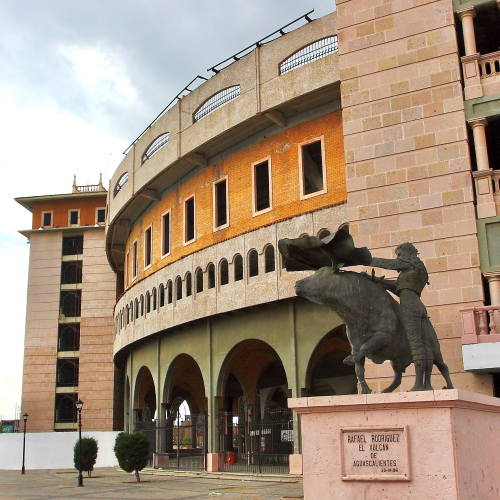
But Aguascalientes is much more. Its railway heritage played a very important role in the industrialization of our country; Among its four oldest neighborhoods, one in particular stands out; the Barrio de la Estación, a symbol of its railway strength. When you visit it, you will get to know the old workshops of this endearing locomotive and if you have time, you can also witness the show offered by the dancing fountains or take a train ride.
As in the heart of any city, here is its famous Cathedral. This building houses the Virgin of the Assumption and is a work of colonial architecture, which stands out for its twin neoclassical towers. In front of the enclosure is the famous Exedra, a monument in the form of a column with an eagle on top, which they say is the true geographical center of Mexico.
There will be no shortage of handicrafts, typical sweets, a purse or traditional toys to keep as a souvenir of your adventures in Mexico. One of the must-see stops during your visit to Aguascalientes is definitely to try their snacks. The chiquiadas, a kind of corn dough empanada fried in butter and filled with some stew.
Year after year, in mid-April, the quiet streets of the city of Aguascalientes become the home of what could be considered the most important fair in our country: the San Marcos National Fair. This festival has become the main element of identification of the hydro-warm capital and is currently one of the most recognized worldwide.
With more than 180 years of history and tradition, the “Mexico Fair”, as it is also known, is a showcase of the best of art and popular culture that offers fun activities for the whole family. Concerts by internationally famous artists, the most notable bullfighting series and livestock exhibition in Latin America, and an exciting casino are some of the attractions that, year after year, captivate millions of visitors.
Tourist Attractions in AGUASCALIENTES CITY
Historical Center
In the city of Aguascalientes there are around the Plaza Patria, buildings that protect its history, the streets of the center have been transformed into pedestrian walkways. Find what to do visiting the Cathedral that dates back to the 17th century, its interior in classic Tuscan style that boasts a unique wooden tubular organ in Latin America; Next to it is the neoclassical Morelos Theater with a museum inside.
The Government Palace that is characterized by its 5 murals, the most splendid in the state; the Temple of San Antonio Padua, built in pink stone and the Temple of Mercy dating from 1765.Walking through its streets allows you to discover endless restaurants, bars, shops, workshops and venues that display the traditions of the state.
Patria Square and Exedra
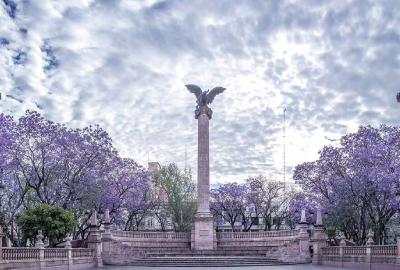
In Aguascalientes they commonly refer to the monument located in the center of the garden of the Plaza Patria with the name of Exedra, which indicates the column that is in the axis of symmetry of the complex with that name. The history of this column dates back to 1808, when the Municipal Council ordered its construction in honor of King Carlos IV of Spain, however, it was completed when Carlos IV had already abdicated in favor of his son Fernando VII.
It is said that an image resembling this new ruler was placed on top of the column, and that it remained there until July 1821, when the Independence of Mexico ended. Although this information has not been confirmed, there is a lithograph by Karl Nebel, where a human figure appears on the base, but this is not an indication of its existence. There are no records of the Exedra for the rest of the 19th century.
In Aguascalientes there is a general belief that the Exedra is the geographical center of the country, there is the idea that the exedra was moved from its original place to better coincide with the center of the country, although the idea is romantic it is a wrong idea.
Government Palace
Built in 1685, this building is the only one still standing from the 17th century. Previously it was a large mansion, the best thing that can be appreciated when visiting it is its red tezontle facade and the balconies carved in pink quarry. It is the last building in the city dating from the 17th century, it is located south of the Plaza de la Patria; Its colonial facade of red tezontle and a set of balconies carved in pink quarry stand out. Inside there are murals by the painter disciple of Diego Rivera, Oswaldo Barrera Cunningham of Chilean nationality.
Before becoming the Government Palace of Aguascalientes, the property was a mansion that belonged to different families and was the headquarters of different places such as the Mesón de la Unión.
Aguascalientes Monumental Bullring
This arena was built in 1974, with capacity for 9,000 spectators. In the following years its facilities were notably improved. Being integrated into the Expoplaza complex in 1992. It currently has a capacity for 15,000 people and the best exponents of bullfighting art have been presented there. On its north side is the statue of Armillita, the most famous bullfighter in Aguascalientes.
Its architecture and ornamentation consist of religious symbolic elements and motifs typical of bullfighting. The chapel was remodeled, a space full of significance where there is an image of the Black Christ of Encino, patron saint of local bullfighters.
San Marcos Island
Within its 44 hectares you can do various activities, such as taking a boat ride on its artificial lake. San Marcos Island has an entertainment area of 44 hectares, you can tour its artificial lake by boat, walk through its paths full of vegetation, a wide variety of musical and artistic events and exhibitions. Come and meet the Mega Velaria, headquarters of the Livestock Exhibition of the San Marcos National Fair, considered the largest and most modern in the world.
Come and admire the largest mechanical clock in Latin America, with its 27 meters in diameter. If you visit it during the fair and you like extreme emotions, take it to the limit with the “Tsunami”, a roller coaster with four loops, unique in Mexico. (available on the dates of the San Marcos Fair). Here art has merged in a beautiful embrace with nature. In addition, it is located inside the city of Aguascalientes, so you will not have to go out to enjoy multiple outdoor activities. Here you will find a space destined for horse racing, and a monumental catrina that is more than 15 meters high.
Old Neighborhoods of Aguascalientes
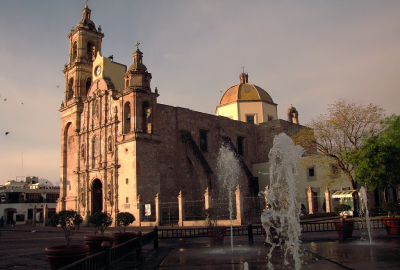
Four were the neighborhoods that were established around the Plaza de la Patria: San Marcos, La Estación, La Salud, El Encino and Guadalupe. On a walking tour enjoy its architectural beauty, immerse yourself in the local culture and enjoy the popular expressions of the town. In them you can also enjoy their temples, gardens, museums and other types of monuments, some dating from the early seventeenth century. Enjoy its architectural beauty, soak up the local culture and enjoy the popular expressions of the town. The neighborhoods that stand out are:
- San Marcos neighborhood, which is the best known in the city and most famous for the San Marcos fair, one of the oldest and most prestigious in Mexico, is celebrated between the months of April and May.
- La Estación, within this neighborhood is the “Tres Centurias” complex, the Station Garden, the “Los Arquitos” Cultural Center, the University of the Arts, the Space Museum, the Thirteenth Forum and the Railroad Sports Center.
- La Salud, one of the oldest neighborhoods in the city, home to the Pantheon of Health and the Roundabout of Illustrious Men, nearby is the Normal School and the Gran Hotel Hacienda de la Noria.
- El Encino, in this is the Black Christ, icon of the neighborhood, there is also the José Guadalupe Posada Museum, in front of the Encino Garden and 3 typical restaurants of the City. The Barrio de la Purísima, famous for its traditional tianguis, its market, the Miguel Hidalgo park, its roundabout and its temple of the Purísima Concepción.
- The last and no less important is the Barrio de Guadalupe, famous for its pantheons “De los Ángeles” and “De la Cruz”, in the heart is the temple and Garden of Guadalupe.
Xocolatl Mexica
As you can imagine from its name, this place is ideal for chocolate lovers. You will be able to taste 40 varieties of xocolatl in drink. Six of the seven flavors with flowers or spices that are manufactured are of Mexican ancestral origin: Magnolia, Chile, Vanilla, Pepper, Cocoa only, Peppermint. Do not forget to take one of its seven chocolates to drink that you can prepare at home.
In this place you can find organic chocolate and foods prepared with this ingredient such as tamales, crepes, fruit and more. Your visit to this site will be quite an experience, because you will be able to select a drink prepared in the old way. The remarkable thing is that it is a 100% Mexican product, if you are one of those who like to consume local products, do not wait any longer and stop by this place when you visit Aguascalientes.
Aguascalientes Tram Tours
Aguascalientes tram tours where you can learn about its culture, its crafts, its traditions and legends and above all its gastronomy. Dare to experience everything on its tram tours through the historic center. Feel the past and present of this city.
San Marcos Garden
Built in 1847 and located in the old Barrio de San Marcos, it is one of the most emblematic gardens in large part because since 1848 there, and in the nearby facilities, is where the famous San Marcos Fair takes place. Its door, fountains, balusters and kiosk are really beautiful, and the benches invite you to sit in the shade of a tree. They say that a ghost comes out every night to pray at the doors of the church.
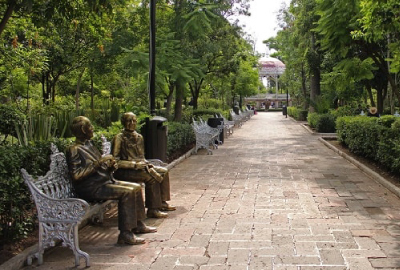
The San Marcos Garden is one of the most representative spaces in the city. It is surrounded by pink quarry balusters, inside this site you can find a wrought iron kiosk, beautiful fountains and benches, ideal for resting on sunny days. It is located a few steps from the San Marcos Fair and next to the San Marcos Temple.
Three Centuries Square
When the three emblematic buildings were built in three different centuries: XIX, XX and XXI, it is that the “Plaza de las Tres Centurias” is named. As a tribute to the city’s railway tradition at the end of the 19th century, it is now an important tourist and recreational area. It is full of tradition and history, the railway tradition has been of great importance in this state and here you can relive the past. There are four attractions within the square that we are sure you will love.
- The Hydrocálida, which is a locomotive that welcomes you to this park, historical, cultural and tourist heritage of the state.
- The Dancing Dountains, you will live from a light and sound show and immersed in this garden.
- Monumental Clock
- Monumental flagpole and flag, you can see the largest flagpole in the entire state and one of the largest monumental flags in the entire country.
Ojocaliente Thermal Baths
Located in the center of Aguascalientes, you will find these historic baths in a neoclassical style with French influence, which have preserved their original hydraulic installations from the 19th century. This famous place is appreciated by city dwellers, since it has hot springs due to their medicinal qualities, especially for arthritis, rheumatism, circulation and stress. Among its services you will find showers, tubs, tank, small, medium and large wading pool, pool, massages and aquafitness classes.
Museums in AGUASCALIENTES
Aguascalientes Museum
The building that houses this museum has a neoclassical style. Whoever visits it will enjoy not only the exhibitions, but also its two patios, gardens and fountains. As part of the permanent exhibitions, there are engravings by Francisco Díaz de León, paintings by Gabriel Fernández Ledesma and engravings by Saturnino Hernán “The most painter of Mexicans and the most Mexican of painters”.
It was built in 1903 and finished by Refugio Reyes, its style is neoclassical. If your thing is cultural tourism, this place cannot be missing from your list of visits. Come and enjoy this place, the best thing is the surprising temporary exhibitions that are presented by national and international artists throughout the year.
Railway Museum
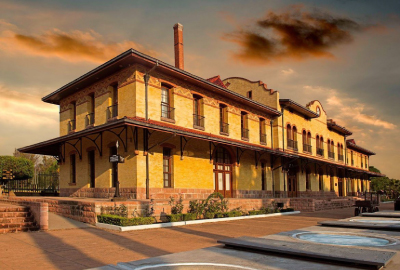
This museum opens its doors in 2003 in what was the station that was inaugurated in 1911. Inside you can find information about the national railway era and see a series of documents, equipment, tools, machinery and more, related to railroads in Mexico.
Preserving the original façade, it is one of the three emblematic buildings of the Plaza de las Tres Centurias, and without a doubt the one that preserves the most anecdotes. You can also visit the office of the telegraph operators and the dispatchers. During your tour you will understand the impact that the railway had on the development of the city in the 20th century.
National Museum of Death
Also known as MUMU, the image of the Museum rescues the renewed and festive personality of the iconography of death and funerary art in Mexico from different historical periods in the country. For this, it shows through its multiple rooms, the different cultural manifestations related to death in Mexico throughout its history. It also has temporary exhibitions where, through different artistic expressions, they also have death as their central theme.
It is a unique place of its kind due to the subject it addresses; death. This theme has been cited by various cultures throughout the ages and has been consolidated in our country since ancient times, with a memory of the traditional and colorful manifestations of death, such as confetti and sugar skulls. A visit that you simply cannot miss.
Aguascalientes Insurgency Museum
Aguascalientes Insurgency Museum, was the first museum in the state and is located in the main house of the Hacienda de San Blas, a place of great importance for the Independence of Mexico, since it was part of the route of Father Miguel Hidalgo. It has two exhibition halls in which you will be able to appreciate farming, mining and textile instruments, all of them a product of the activities that were carried out in the hacienda; as well as objects of daily life from past times.
Jose Guadalupe Posada Museum
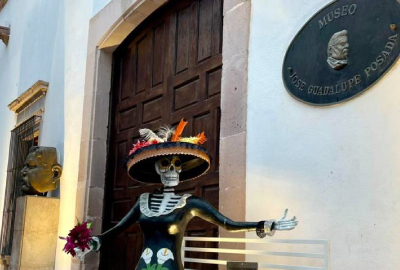
Before, the museum was the priest’s house. It opened in 1972 as the first art museum in the state. It is located in the center of the city of Aguascalientes, next to the El Encino temple.
Paying homage to the famous Mexican engraver, illustrator and caricaturist José Guadalupe Posada, a native of Aguascalientes, the Museum adapted its corridors to house more than 600 pieces including original plates and prints belonging to the José Guadalupe Posada collection in the permanent room. There are also works by authors such as José Fors, Tamayo, Mimo Paladino, among others.
It also has a recreational area, souvenir shop, cafeteria, a research and consultation center, as well as an engraving workshop in which classes are given for children, youth and adults. Don’t forget to take your photo with La Catrina, the original metal engraving from 1912.
“Espacio” Museum
It is located in the complex that is part of the old railway workshops, in buildings 53 and 56, the ships that constitute it were at another time the Mechanical Carpentry workshop, where molds and models for the manufacture of shoes were built. It is a venue created for Contemporary Art and its various expressions.
Its mission is to preserve the architectural and historical heritage of the old locomotive workshops, as well as to bring the community closer together and spread among them the imprint for the social, economic and industrial development that they represent. One of its main objectives is to link the general public to the different contemporary artistic practices, through exhibitions, exhibitions, workshops, projects and activities.
Aguascalientes Regional History Museum
The Regional History Museum of Aguascalientes was inaugurated in October 1988, in a construction for a house from the beginning of the 20th century (1908), a sample of the virtuosity of the architect Refugio Reyes Rivas. Its constructive, spatial and formal characteristics are a clear example of the typical solutions of the historicist architecture of the time.
Based on the traditional division of patio houses, with a hallway and a fence, through which the central patio is reached, with its perimeter corridors, the architect transformed the spatial structure with two resources: the first, placing the space as the access point the dining room, with its art nouveau windows, and the second, with a rounded corner with an arch and lintel, unique in the region. The chapel of the house is located in the west wing of the courtyard, with a neo-Gothic style wooden altar.
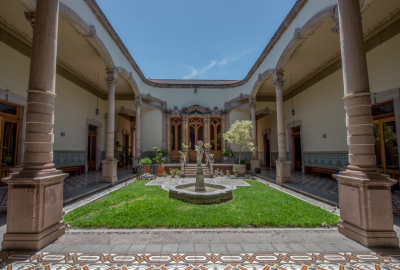
The museum’s discourse contemplates four themes:
- Paleontology, gives a general idea of the geological conditions of the State, highlighting its collection, especially the endemic fossils.
- Archeology, different pieces from the region are exhibited that allow us to develop an idea of the cultural level of pre-Hispanic groups.
- Stories of faith, taking advantage of the chapel of the house with its altar worked in wood, the theme of religiosity, its cultural importance and evolution over time is developed.
- Conquest, dedicated mainly to the themes of the Chichimeca war, the silver route, the royal road inland and the construction of the prison until reaching the Aguascalientes Foundation.
Museum of Contemporary Art No. 8
It belongs to the Cultural Institute of Aguascalientes. It was inaugurated in April 1991, in a building on Juan de Montoro street. Later, in June 1998, it was reopened in the facilities of the estate called Number 8. It exhibits a collection made up of the winning works in the National Contest of Students of Plastic Arts (1966-1979) and in the National Encounter of Young Art. (1980 to date), which is called by various cultural institutions as part of the activities of the San Marcos National Fair.
It has a representative collection of contemporary art in Mexico, it gathers and serves as a venue for the award-winning works at the National Encounter of Young Art. Among the main artists who have exhibited their work are Luciano Spanó, José Castro Leñero, Aarón Cruz, John Hall and contemporary Chilean artists, Rosa Luz Marroquín, Omar Rayo and Derek Besant. It has a permanent room dedicated to the work of Jalisco artist Enrique Guzmán Villagómez.
Museum of the Traditional Mexican Toy
The museum is located on a farm that was adapted for this purpose. This museum is of a community nature and its objective is to spread the traditional Mexican toy from all regions. It exhibits more than a thousand pieces in its three permanent rooms, in addition to a traditional toy creation workshop. It has 3 permanent exhibition rooms classified according to the cultural diversity of the country, 35 m2, where the traditional Mexican toy is exhibited.
“Descubre” Museum – Interactive Science and Technology Center
It is located in a building built expressly with a project by the López Guerra architects office. It opened its doors to the public on November 20, 1996, with the aim of promoting knowledge of science and technology among the population, through interactive activities and programs aimed at people of all ages. The museographic concept was carried out by the Evolución company.
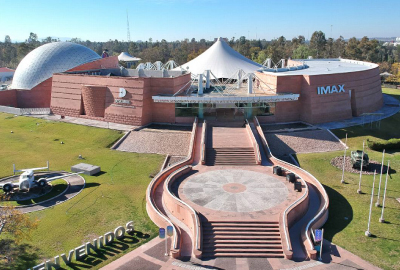
The areas that make it up bear the names of Universe-astronomy, Planet-geology, Environment-biology, Development-anthropology, Technological development, Garden of science-physics and Armalito, the latter remodeled in 2002. It has an IMAX screen for projections of large-format films, auditorium, library, video library, cafeteria and shop.
Escárcega Museum (MUSE)
Initiative of Ing. Eduardo Escárcega Rangel, the museum has an important collection of local, national and international graphics and painting, of modern and contemporary styles. It offers the public temporary exhibitions, music, dance, theater, literature, cinema, workshops and conferences.
It has 18 permanent rooms in which works by Octavio Bajonero, Rafael Coronel, Rafael Zepeda, Jordi Boldó, Patricia Herníquez, Gabriel Macotela, Boris Viskin, Francisco Toledo, Mario Benedetti, Carlos Castañeda, Roger Von Gunten, Santiago Cárdenas, Alfredo Zermeño are exhibited. Adolfo Mexica, Vicente Rojo, Benjamín Manzo, Martha Chapa, among others.
The temporary gallery Hidrocálidos MUSE Artists, is made up of an average of 100 pieces by just over 50 local authors and is located in the basement of the museum with special lighting to maintain the temperature that prevents damage to the works.
Los Arquitos Cultural Center
The construction of this building was approved by the City Council in 1821. Originally, the building functioned as a public bath house, with medicinal properties from the hot springs. These baths received water from an aqueduct that was about 348 meters long, which served to supply 13 tubs, a garden, 4 open-air baths, public laundries and a pool known as La Puga.
Today this Los Arquitos Cultural Center was declared a historical monument in 1990, and was the object of an architectural rescue and restoration in early 1993, turning it into a site dedicated to art and culture. The construction of the Museum allows to appreciate a combination of styles of which the neoclassical of the San Carlos Hotel stands out, together with a neogothic archery. The museum brings together objects and memories of the old activity that took place in Aguascalientes.
Theaters in AGUASCALIENTES
Morelos Theater
It was designed by the engineer José Noriega and inaugurated on October 25, 1885 with the Italian drama La muerte civil, directed by Leopoldo Burón. In 1914 it was the site of the Sovereign Revolutionary Convention of Aguascalientes. On March 30, 1993, the property was declared, by presidential decree, a Historic Monument of the Nation. It offers theater, opera, music, dance, variety shows, children’s events, festivals and conferences.
Aguascalientes Theater
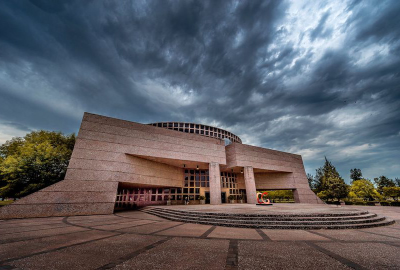
Aguascalientes Theater, its architectural design is modernist style, majestic stage with capacity for 1,650 spectators. It was designed by the architect Abraham Zabludowsky, in a modernist style, this stage was inaugurated on October 3, 1991 with the work Antología de la Zarzuela, directed by José Tamayo. It is considered the maximum stage to promote culture and art in the city. During the San Marcos National Fair, the folkloric show known as “Fair” is presented in this venue; it also presents plays, opera, music, dance, children’s shows, festivals, conferences and government reports.
Theater Antonio Leal and Romero
It is part of the facilities of the House of Culture whose building dates back to the 18th century and had several uses over the years, including: family residence, school for girls, cloister for nuns, federal school and currently the headquarters of the Cultural Institute of Aguascalientes . It was inaugurated on October 16, 1986. Theater and music shows, festivals, children’s events, film screenings, as well as civic and school ceremonies are held there.
Victor Sandoval Theater (before Theater of the Park)
The place it occupies today is part of the re-adaptation of the set of spaces of the Craft Design Center built in 1971 and designed by the architect Carlos Parga. It is integrated into the School of Dance. It offers theater shows, music, dance, children’s events, festivals and conferences. During the period that the San Marcos Fair lasts, important cultural and artistic events take place.
The Puga Forum
It is part of the facilities of the Los Arquitos Cultural Center. It was built in 1882 and inaugurated on May 31 of the same year, having different uses over time: bathrooms and pools (the first, built for the recreation of the inhabitants of the city, in addition to being the largest public laundries in the center of the Republic); Later it was a school, a house and a hotel.
The forum, which was the first public pool in the state, was designed and built by Antonio Puga Álvarez. The adaptation and remodeling of the space was carried out by the architect José Luis García Ruvalcaba and concluded in 1994, reopening in November 1997. Theatrical and musical shows are performed in this space.
Religious Architecture in AGUASCALIENTES
Aguascalientes Cathedral
The Basilica Cathedral of Our Lady of the Assumption is one of the most easily recognized landmarks in Aguascalientes, due to its pink stone construction and huge towers. Visit this impressive structure in Plaza de la Patria and see the fabulous paintings below its vaulted ceilings.
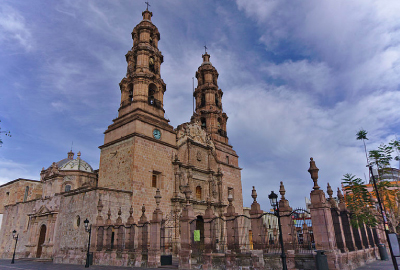
Erected as episcopal seat of the diocese in 1899, and an active church, although anyone can enter and enjoy the beauty of the building. This building dates from the year 1704 and was completed in 1738, although it was known as the Parroquia de la Asunción. The Cathedral is a splendid example of colonial architecture, whose Solomonic baroque-style work was carried out under the auspices of the parish priest Manuel Colón de Larreategui. The construction consists of twin towers that show a neoclassical style in their curved pediments.
The interior has a basilica plan, with three domes, abundant decoration with plant motifs and mortar reliefs. A beautiful white marble cypress stands out, where the figure of the Virgin of the Assumption, patron saint of the city, is housed. It has a beautiful choir and episcopal throne at the back of the High Altar.
San Jose Temple
In 1685 the Juaninos settled in the Villa de Nuestra Señora de la Asunción de las Aguas Calientes; Hospitaller Order of San Juan de Dios whose mission was to build a hospital, a cemetery, a convent and a chapel.Father Prior Juan de Dios Patiño founded the then first Juanino hospital and convent together with the Temple of San Juan de Dios, which changed its name in 1909 to that of the current patron.
The tower, as well as the access to the temple, are decorated with reliefs, heights and decorations of varied structures without geometric shapes, characteristic of the neoclassical. Inside the temple, its golden finishes on the interior columns, altars and repose rooms dazzle, especially on the main altar where the Virgin Mary, Saint Joseph and Jesus Christ are found.
The temple has characteristics of the Mexican late baroque, especially for the estipite-type pilasters; although, like many religious buildings of the 18th century, it also has neoclassical elements, such as the three-body tower. In the interior part you can see the enormous paintings of the Via Crucis created by Andrés López dating from 1798. It was built in yellow quarry; It has twelve altarpieces that represent the stations of the Via Crucis made by Andrés López.
Temple of the Lord of Encino
With an exquisite and highly detailed facade, there is no doubt that it is one of the most beautiful churches in Aguascalientes. Enjoy and appreciate the baroque architecture, with some neoclassical characteristics, typical of the 18th century, mainly in its three-body tower. Its main doorway, an exuberant ultra-baroque jewel, made up of two horizontal bodies and three vertical entrecalles.
Inside you will be able to meet the Black Christ of the Encino that, supposedly, appeared to a hydrocalid while cutting firewood from an oak tree. You can also see the huge paintings of the Via Crucis created by Andrés López dating from 1798. It was built in yellow quarry; It has altarpieces that represent the stations of the Via Crucis made by Andrés López.
Temple of San Antonio de Padua
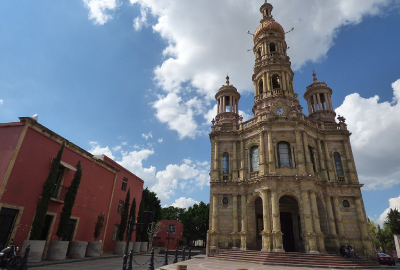
In the very heart of Aguascalientes, stands this masterpiece designed by self-taught architect Refugio Reyes Rivas. Starting in 1895, the construction ended in 1908. It is considered a religious masterpiece of Aguascalientes. It presents a fusion of various architectural trends such as Gothic, Neoclassical, Baroque, Arabic and even Russian, the latter reflected in the small dome that has its main tower. Inside you can enjoy the frescoes with evangelist themes, its double drum dome and the chapels dedicated to Santa Rita de Casia and the Holy Sepulchre.
The Temple of San Antonio began to be built in 1896 under the baton of master Refugio Reyes Rivas, concluding its work in 1906. But it had to wait until 1908 to see its doors open to the public. It reflects the fusion of various architectural currents such as Gothic, Neoclassical, Baroque, Arabic and even Russian, the latter reflected in the small dome that has its main tower.
Built with quarry from the same region in shades of green, yellow and pink, its three towers stand out: the central tower of two bodies with a circular surface topped with a small dome with a lantern and the other two towers of one body only with a circular floor plan. In this temple, Master Salvador Melchor Martínez, titular organist between 1974 and 1996, currently considered among the best in Mexico, showed his extraordinary musical abilities. Currently this venue is the most requested to play the wedding march.
Temple of San Marcos
Another example of that cross between baroque and neoclassical that distinguishes many churches in Mexico. Concluded in 1765, this church hosts the San Marcos National Fair and has a beautiful garden.
Temple of the Immaculate Conception
Together with the roundabout of the same name, the Purísima Temple is one of the most familiar postcards of Aguascalientes. This imposing neo-Gothic style church is relatively recent, having only been completed at the beginning of the 20th century.
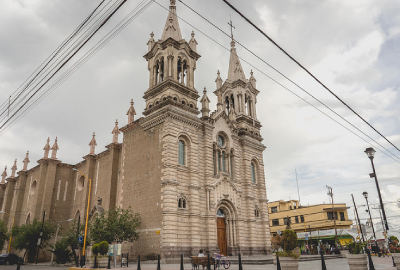
It is located in the Barrio de la Estación. Neo-Gothic in style, the work of José Refugio Reyes, completed at the beginning of the century. In the first body, access is manifested through a semicircular arch with an archivolt, a composition of stepped columns and an empty niche in the center; In the second body, the choir window stands out, made up of four semicircular arch windows, a circular clock and, topping off the cover, a mobile cornice with a sculpture of La Purísima.
Parish of Our Lady of Guadalupe
Construction began on the work of master Felipe de Ureña in 1767, and was completed 20 years later. It is a building that has undergone multiple transformations in its structure. The façade is exuberantly baroque, characteristic of the Bajío consecrated by its stone filigree. The enormous dome is covered on the outside with Talavera tile, also called handkerchief.
The interior of the sanctuary has a very ornate decoration; the sculptural and pictorial decoration is of great quality. The beautiful pulpit made of tecali, a volcanic stone similar to marble, and the four paintings on the pendentives with the four apparitions of the Virgin are worthy of admiration. The painting of the Virgin was made by José de Alcíbar in the second half of the 18th century. The Santísimo chapel, located at the back of the temple and built at the beginning of this century, is neo-Gothic in style. Inside you can see the breasts decorated with paintings referring to the four apparitions of the Virgin of Guadalupe.
Temple of the Sacred Heart of Jesus
Its facade carved in pink quarry, is composed of a portal and two towers. The cover consists of a body and auction; you can admire beautiful profusely carved stipes pilasters and among them, niches with sculptures of the apostles Saint Peter and Saint Paul; in the auction, a sculpture of the Sacred Heart that rests on a pedestal under which it has the inscription “Come to me all”. The interior has a basilical plan where the pink quarry predominates.
Sagrario Parish (El Conventito)
Temple adjoining what was the “Convent of San Ignacio de las R. R. Monjas de la Enseñanza”, from which it took the name of “Conventito”, this temple is today converted into the Sagrario Parish. Its construction began on July 3, 1850, a neo-Gothic style façade with masonry walls and several windows with pointed and lobed arches, two in trefoil and two with mullioned windows.
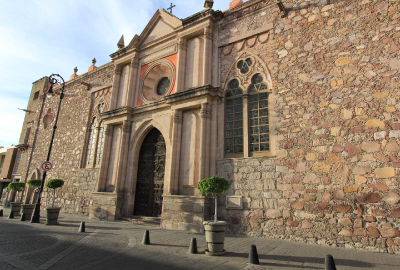
As a finishing touch to the façade there is a curl with reliefs of plant motifs, gargoyles and quarry vases. Called “El Conventito”, the neo-Gothic style façade features masonry walls and several windows with pointed and lobed arches, two in cloverleaf and two with mullioned windows. As a finishing touch to the façade there is a curl with reliefs of plant motifs, gargoyles and quarry vases.
San Diego Temple
In the heart of the Historic Center of the hydro-warm capital, its inauguration took place in 1647. At the time it became the largest temple in the entire state of Aguascalientes. Something that stands out greatly with respect to the Temple of San Diego, are the iconographic elements related to the Marian devotion that it possesses, as well as the four polychrome altars that it treasures.
The latter are dedicated to San Joaquín, Santa Ana, San José and Jesus Christ. His harmonious style is fully installed in the neoclassical baroque. The pleasant contrast that exposes its austere façade with the ornamental opulence of the complex stands out. For example, in the sacristy of the Temple of San Diego you can see valuable paintings by Juan Correa, dedicated to different episodes in the life of San Francisco.
Map of Tourist Attractions in AGUASCALIENTES CITY
More Tourist Attractions in AGUASCALIENTES
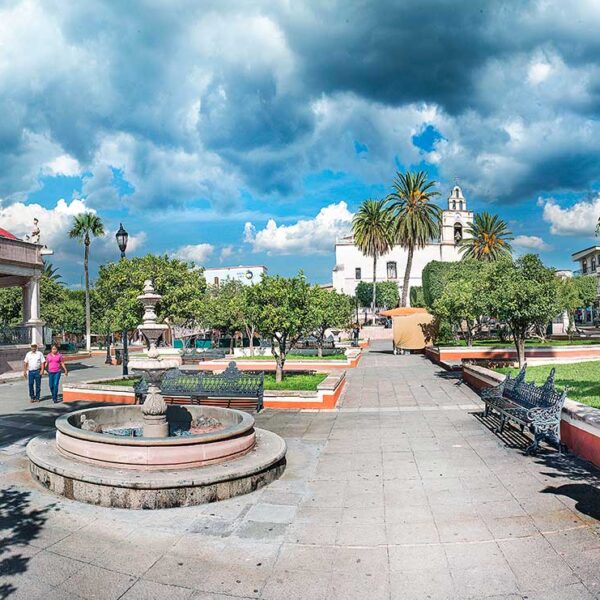
Magical Towns in Aguascalientes
Aguascalientes has three magical towns that are an excellent option to discover them at any time of the year, mainly on vacation. Calvillo, San José de Gracia and Real de Asientos are considered magic towns because they are places with symbolic attributes and transcendental events that marked their history, becoming alternatives for national and foreign tourists, and even for the people of Aguascalientes eager to know and live their history. In these three municipalities you can enjoy a vast gastronomy, festivals and traditions, as well as a great wealth of heritage, giving visitors the opportunity to live unique experiences.… Read More
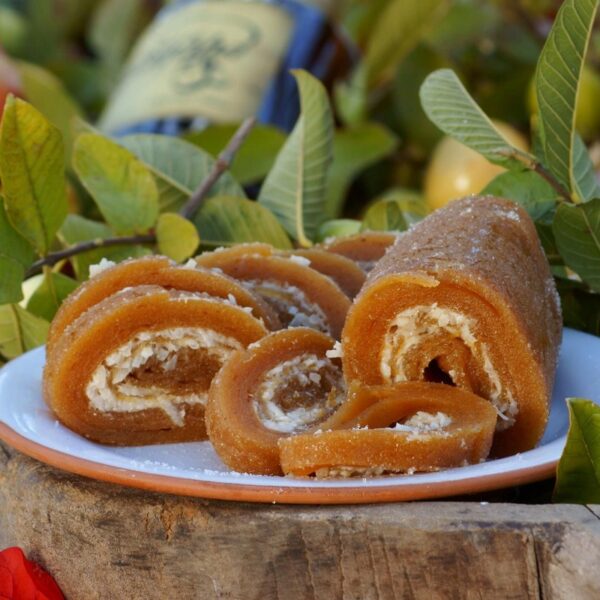
Gastronomy of Aguascalientes
Aguascalientes is one of the smallest states in Mexico and which has a lot to offer to those who visit it. In fact, throughout history its geographical location has contributed to enrich its culture and gastronomy, thus becoming a unique multicultural mix. For this reason, in Aguascalientes you can find foods that are made throughout the country but with its own particular and unique touch. For example, this state has drinks that are inherited from pre-Hispanic times and delicious desserts made with native fruits.… Read More
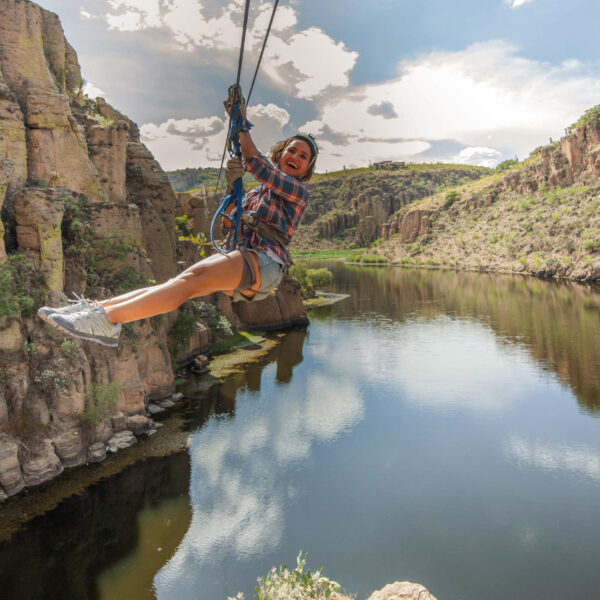
Ecotourism and Adventure in Aguascalientes
Ecotourism in Aguascalientes is lived in semi-desert landscapes, dams and trails surrounded by nature and cave paintings. Living ecotourism in Aguascalientes, you will love the beauty of its natural settings and the experiences that you can live here. The state is made up of vast semi-desert landscapes, with oases surrounded by water and fun ecotourism activities. In Aguascalientes there are several spaces close to the city where you can spend a weekend away from the hustle and bustle, in a much calmer and quieter environment, as well as of course getting a little active and exercising a little.… Read More
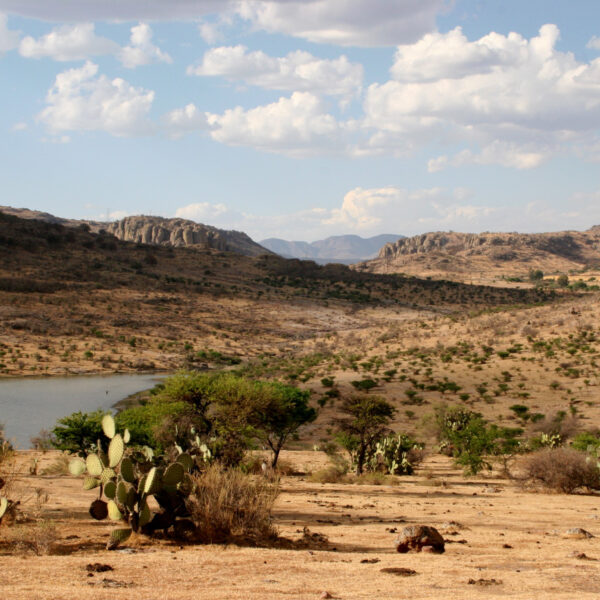
Archaeological Sites in Aguascalientes
Archaeological Sites in Aguascalientes stand out for their biodiversity, natural and cultural wealth, the inclusion of surrounding communities and collective enjoyment. These are four archaeological areas, El Ocote, La Montesita, Cerro de Enmedio and Santiago, which have also been delimited for their cultural value as geosites by the UNESCO Geopark Project “Water Routes”.… Read More
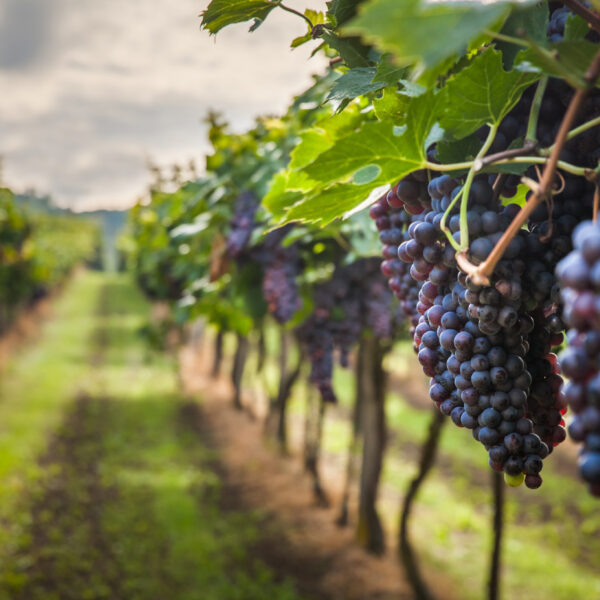
Aguascalientes City Surroundings
In Aguascalientes there is much to admire, from springs to charming towns and old haciendas. Further exploration of the state often includes visits to mineral springs. In the countryside surrounding the capital there are also beautiful old haciendas and colonial buildings, spas and the imposing Sierra Fría. If you like sports, you can practice rock climbing, rappelling, fishing, mountain biking and camping in the rural areas of the state.… Read More
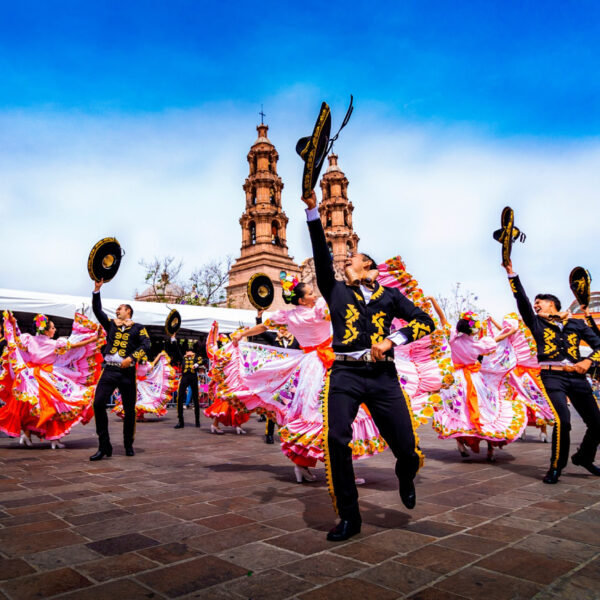
Traditions of Aguascalientes
Aguascalientes is a state of traditions and customs, a destination famous for its internationally recognized fairs and festivals; It is prepared to receive tourists and visitors throughout the year, some of its main tourist attractions are the San Marcos National Fair, the Skulls Cultural Festival, the Grape and Artisanal Cheese Fair.… Read More
Flights & Hotels in AGUASCALIENTES
More Tourist Attractions in MEXICO

Traditions in Mexico
It is practically impossible to make a meticulous, and above all, accurate selection of the places to visit in Mexico. Each place that our country houses is unique and beautiful in its own way. Mexico, with its nearly 2 million km², has a large number of scenarios to offer, as well as endless activities to do. Do not lose your way and enter the places to visit in Mexico. In Mexico, apart from the beaches and its famous archaeological sites, there are many other really interesting sites and activities that you should know. In the surroundings of the main cities you will find places full of culture and tradition, where you can spend relaxing, interesting and fun vacations. On your trip through Mexico you cannot stop obtaining souvenirs, the crafts that are made here are of the highest quality and recognized worldwide. A shopping tour cannot be missed.… Read More

Archaeological Sites
The Archaeological Zones are the cultural past of every Mexican. You will be amazed at the ambient, nature and the environment that surrounds them. Climbing to the top or being around it will take us back in time to admire every detail. México is a country of culture and traditions, many of which we have inherited from the pre-Hispanic inhabitants of this vast territory, although it is true that there were more settlements in the central and southern part of the country, it is also possible to find some archaeological remains in the north.
… Read More

Ecotourism and Adventure
Mexico is one of the best countries for Ecotourism as it has a great variety of flora and fauna, as well as a large number of refuges for extraordinary species. You can enjoy recreational activities of appreciation and knowledge of nature through contact with it, such as: stargazing, observation of natural attractions, wildlife and bird watching. Throughout México there are more than 176 protected natural areas, 5 of them considered by UNESCO as Natural Heritage of Humanity. Just for this and much more, we believe that Mexico is a Paradise for Ecotourism.… Read More

Magical Towns
A Magical Town is a place with symbols and legends, towns with history that in many cases have been the scene of transcendent events for our country, they are places that show the national identity in each of its corners, with a magic that emanates from its attractions ; visiting them is an opportunity to discover the charm of Mexico. The Magical Towns Program contributes to revalue a set of populations in the country that have always been in the collective imagination of the nation and that represent fresh and varied alternatives for national and foreign visitors. A town that through time and in the face of modernity, has conserved, valued and defended its historical, cultural and natural heritage; and manifests it in various expressions through its tangible and intangible heritage. A Magical Town is a town that has unique, symbolic attributes, authentic stories, transcendent events, everyday life, which means a great opportunity for tourist use, taking into account the motivations and needs of travelers.… Read More

Gastronomy
The Gastronomy of Mexico has a great diversity of typical dishes, which is why it was recognized by UNESCO as Intangible Heritage of Humanity. The basic and representative ingredients of Mexican dishes are: corn, coriander, chili, beans, piloncillo, nopal and tomato. Mexican cuisine is also characterized by its sauces, which serve as an accompaniment to traditional dishes, prepared based on spices.… Read More

States Of Mexico
Mexico has an incredible diversity of landscapes, where the beauty of its beaches, internationally recognized, stands out. In its vast territory of coasts, there are beaches of unparalleled beauty, and colorful landscapes. A large network of first-class hotels and tourist services is available to visitors to these beaches. Mexico is also mystical places, dotted with archaeological testimonies inherited from its original inhabitants. Monuments made by the Mayas, Aztecs and Toltecs are located in magical landscapes, like lighthouses in an ocean of natural beauty. They offer visitors buildings that tell their history, and museums that collect their cultural heritage. And that keep alive ancestral traditions, in ceremonies and festivals, where you can enjoy cultural activities and entertainment.… Read More

Beaches
On the Beaches of Mexico you can immerse yourself in the intense blue ocean of the Pacific bays, sunbathe on the shore of the warm and transparent waves of the Caribbean Sea in Quintana Roo or even rest on the beautiful coasts of the Gulf of Mexico. Mexican beaches hide wonderful secrets for the traveler. By visiting them, in addition to enjoying the excellent climate and water activities, you can discover splendid archaeological sites and interesting colonial cities without traveling long distances.… Read More

Capital Cities
Folklore, gastronomy, literary culture, art and exhibitions, is what you will find in the capitals of the states of Mexico. To the north, colonial Mexico, Puebla, Guadalajara, Guanajuato, the Sonoran desert and the California peninsula. To the east Veracruz and the gulf. To the west Acapulco, Oaxaca and Tuxtla Gutiérrez. And to the south the Riviera Maya and the pyramids of Chichén-Itzá, Tulúm and Cobá in Yucatán, Palenque in Chiapas, the cenotes, and the Central American jungles.… Read More

